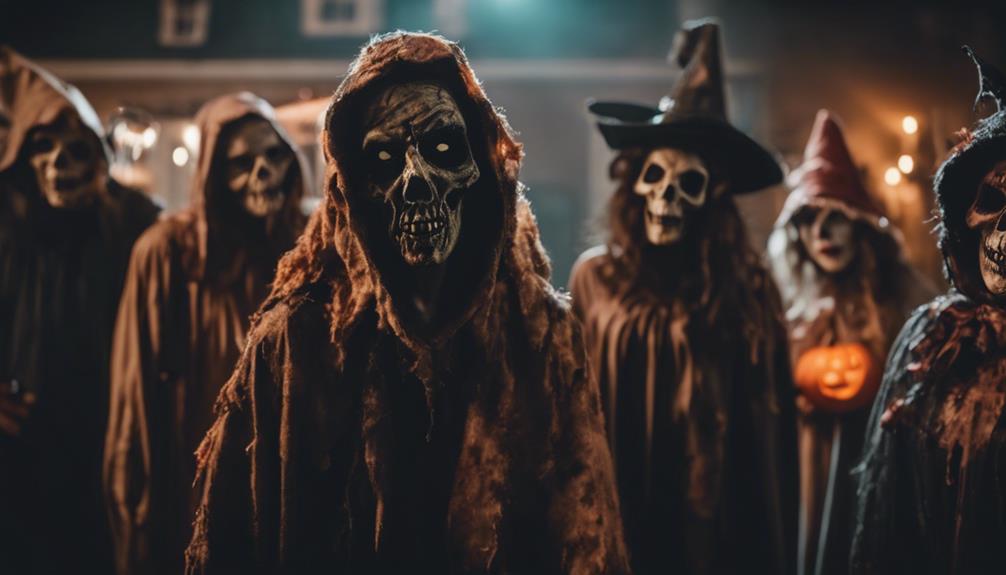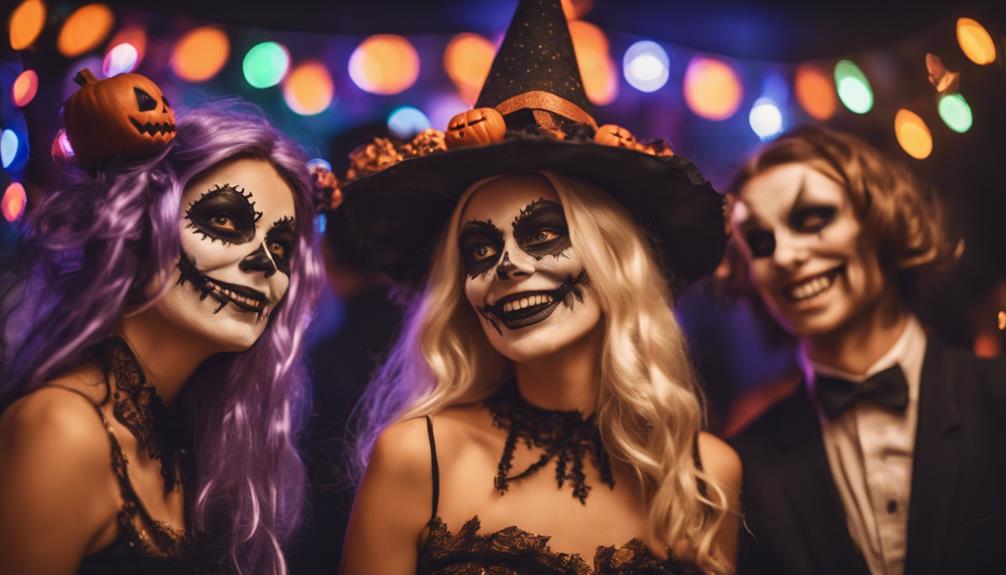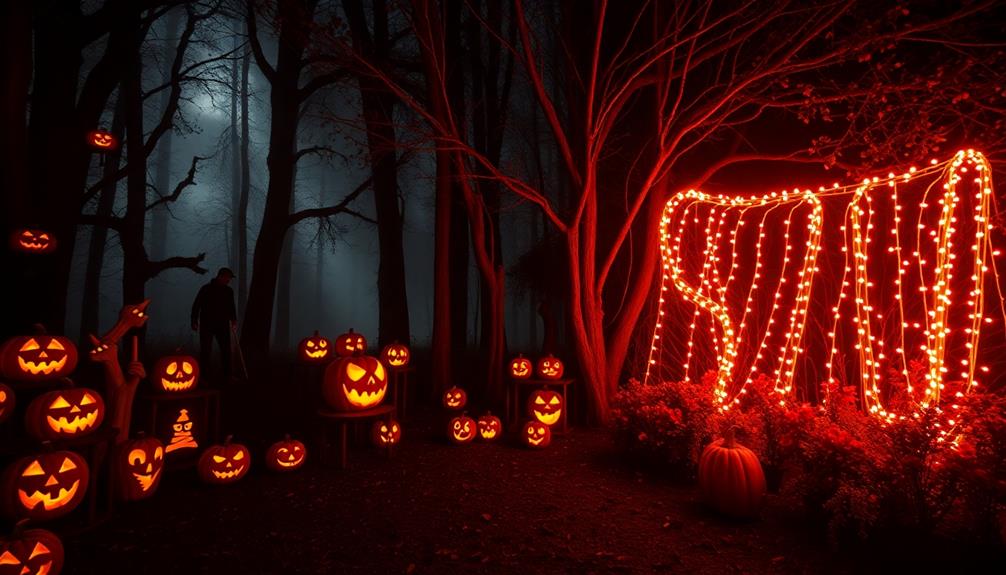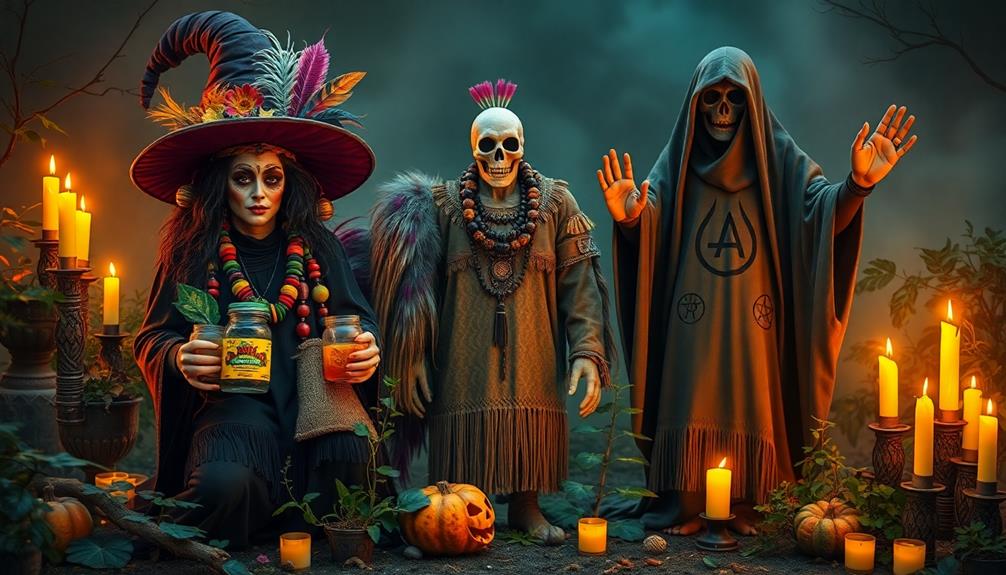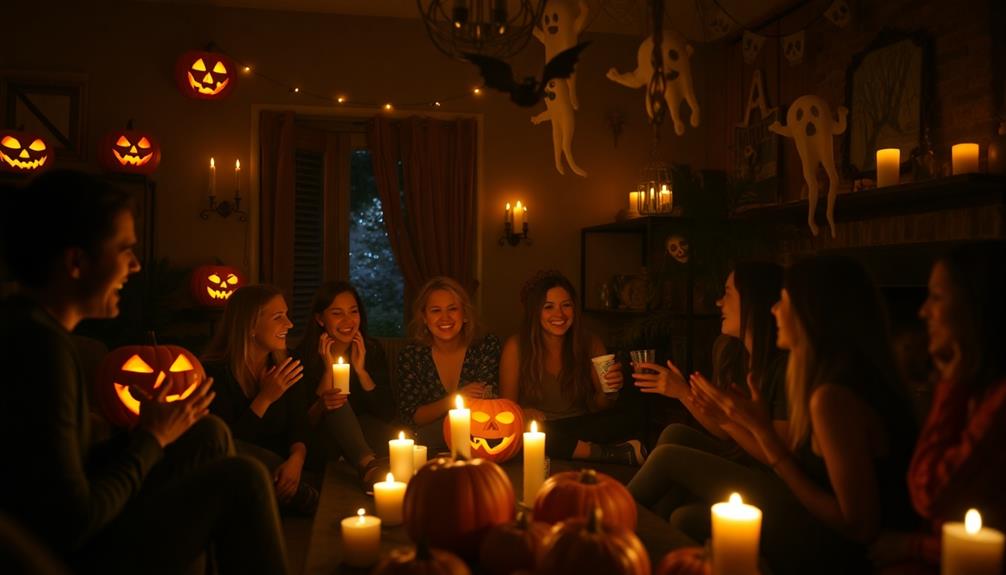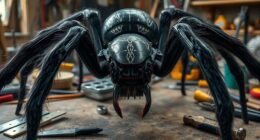On Halloween, scary costumes have a deep-rooted history tied to ancient Celtic rituals. People dressed in frightening attire to protect themselves from malevolent spirits believed to roam freely during Samhain. Through the ages, these costumes evolved as a way to connect with the supernatural domain and honor ancestors. Wearing scary outfits serves as a symbolic acknowledgment of the link between the living and the dead, reflecting a historical need to confront fears. The psychological impact of scary costumes triggers primal instincts and societal perceptions vary based on cultural backgrounds. Explore further to uncover why these costumes continue to intrigue and mystify.
Key Takeaways
- Scary costumes stem from ancient beliefs in warding off malevolent spirits during festivals like Samhain.
- Tradition evolved to embrace fear, honor ancestors, and explore the mystical realm.
- Psychological thrill factor and controlled fear provide entertainment value on Halloween.
- Social perceptions and cultural influences shape the acceptance and enjoyment of scary attire.
- Marketing trends, pop culture, and diverse options drive the evolution of scary costumes in celebrations.
Historical Origins of Scary Costumes
Scary costumes on Halloween trace their roots back to ancient Celtic festivals like Samhain, where disguises were donned as protection against malevolent spirits. During Samhain, the Celts believed that the boundary between the living and the dead blurred on October 31, allowing evil spirits to roam freely. By wearing frightening costumes, they aimed to blend in with these spirits and avoid any harm that might befall them. Druids, the Celtic priests, also used costumes during Samhain to make predictions about the future, tapping into the supernatural energies believed to be present during this time.
The influence of Roman festivals like Feralia and Pomona further shaped the early traditions of scary costumes on Halloween. As time passed, the evolution of Halloween costumes was also influenced by the blending of Celtic beliefs with Christian customs. This blending of traditions over the centuries has contributed to the diverse and rich tapestry of Halloween costume traditions we see today.
Evolution of Halloween Costume Traditions
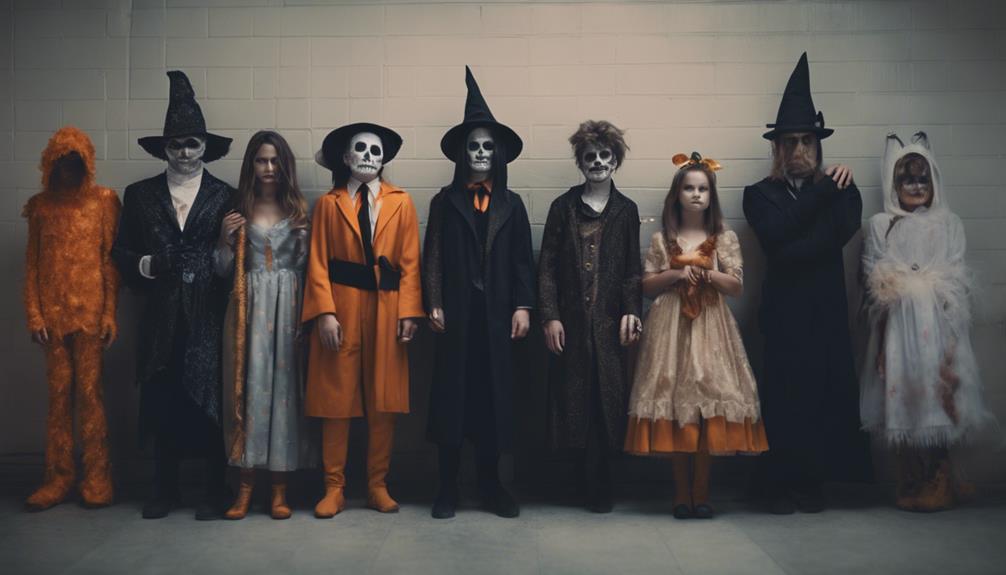
Reflecting centuries of cultural blending and creative innovation, Halloween costume traditions have undergone a fascinating evolution from their ancient Celtic origins to the diverse array of attire seen today.
The Celtic festival of Samhain, where costumes were donned to ward off evil spirits, laid the groundwork for modern Halloween traditions. Early practices like mumming and guising involved wearing costumes to mimic supernatural beings, paving the way for the spooky outfits we see today.
From homemade disguises to mass-produced costumes featuring monsters and vampires, the evolution of Halloween attire has been marked by a shift towards more elaborate and frightening designs. In recent years, pop culture icons and superheroes have become popular costume choices, adding a contemporary twist to the Halloween dress-up culture.
Costume parties have surged in popularity since the 1930s, providing a platform for people to showcase their creativity and don their scariest or most innovative outfits.
Cultural Significance of Scary Outfits
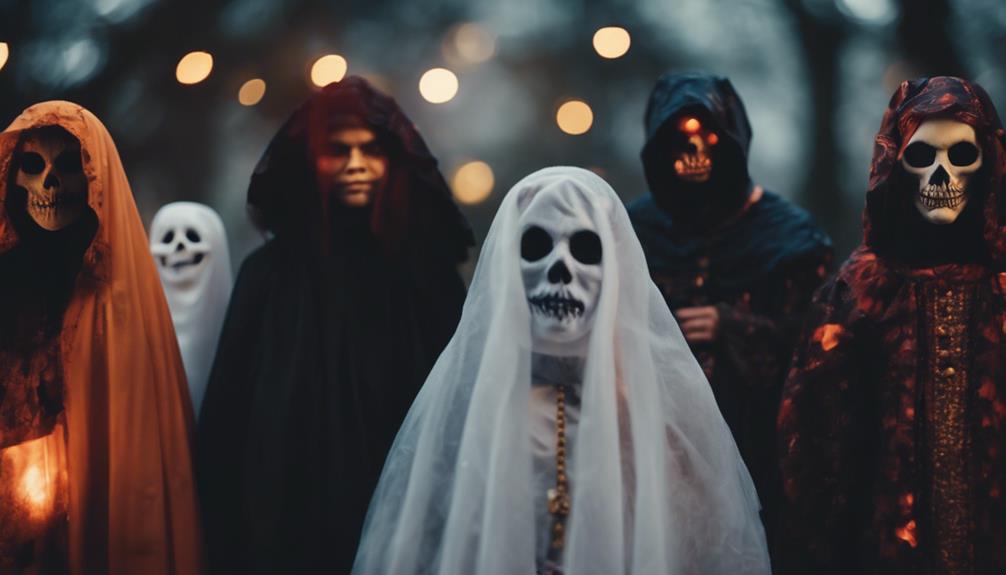
The cultural significance of scary outfits on Halloween is deeply rooted in ancient traditions and beliefs. Originating from Celtic festivals like Samhain, where people believed that spirits roamed the earth, individuals dressed in scary costumes to ward off evil and protect themselves. These outfits symbolize a connection between the living and the dead, honoring the supernatural world.
By wearing scary attire, people acknowledge the existence of spirits and the unknown, celebrating the mystical domain that lies beyond. Halloween costumes reflect a historical context where facing fears and embracing the mysterious were essential aspects of life.
Through these traditions, the cultural significance of scary outfits goes beyond mere dress-up; it's a way to pay homage to our ancestors, confront our fears, and immerse ourselves in the rich tapestry of beliefs that have been passed down through generations.
Psychological Impact of Scary Costumes
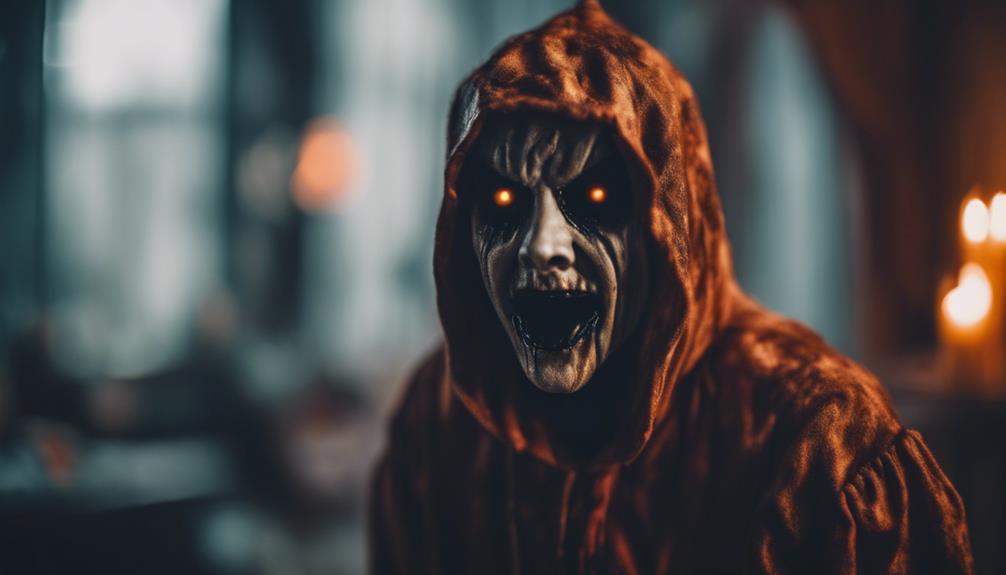
Wearing scary costumes on Halloween can evoke primal instincts, triggering a psychological thrill factor that heightens your senses.
These fear-inducing visual stimuli have the power to induce a rush of adrenaline, making your heart race and your palms sweat.
The psychological impact of scary costumes can vary based on personal experiences, cultural influences, and individual fears, shaping how you perceive and react to the spooky festivities.
Fear-Inducing Visual Stimuli
When encountering fear-inducing visual stimuli like scary costumes on Halloween, individuals often experience heightened physiological responses and negative emotions. The sight of scary Halloween costumes can trigger fear and anxiety, causing your heart rate to increase and provoking unsettling emotional reactions.
Exposure to these costumes may lead to lingering negative associations and even desensitization to fear over time. Social influence plays a significant role in the choice of scary costumes, impacting how you experience Halloween. Your personal fears, phobias, and past experiences also heavily influence how you respond to scary Halloween costumes.
Factors such as age, societal norms, and the appearance of the costume can all affect how scary it's perceived to be, shaping your reactions. So, when faced with a particularly frightening costume, bear in mind that your physiological and emotional responses are natural reactions to fear-inducing visual stimuli.
Evoking Primal Instincts
Triggering primal instincts, scary costumes on Halloween evoke the fight or flight response in the brain. When faced with frightening stimuli, your body reacts instinctively, causing your heart rate to rise and feelings of fear and anxiety to surface.
These emotional states aren't uncommon during the festival, as negative associations with scary costumes can linger post-exposure. It's fascinating how social influence plays a pivotal role in your choice of costume, shaping your Halloween experience.
Exposure to scary costumes can even lead to desensitization over time, altering how you perceive and react to fear-inducing situations. Be mindful of how these costumes affect your primal instincts and emotional well-being, as they can have a significant impact on your overall Halloween experience.
Embrace the thrill, but remember to prioritize your emotional comfort amidst the spooky festivities.
Psychological Thrill Factor
Evoking a sense of intrigue and unease, the psychological impact of scary costumes on Halloween explores the complex interplay between individual perceptions and societal influences. When you encounter someone in a frightening costume, your brain may trigger fear responses, causing elevated heart rates and physiological reactions. These reactions can stem from past experiences, cultural norms, personal fears, and developmental stages. The appearance of the costume, the age of the individual, and societal judgments all play a role in how scary the costume appears to you.
Exposure to scary costumes can lead to lingering negative associations and may influence your own costume choices. Understanding the psychology behind the thrill of scary costumes involves acknowledging the biological, cultural, and imaginative factors that contribute to fear responses. So, next time you feel a shiver down your spine at the sight of a spooky costume, remember that it's a complex interplay of your mind, past experiences, and societal influences at play.
Social Perceptions of Scary Attire
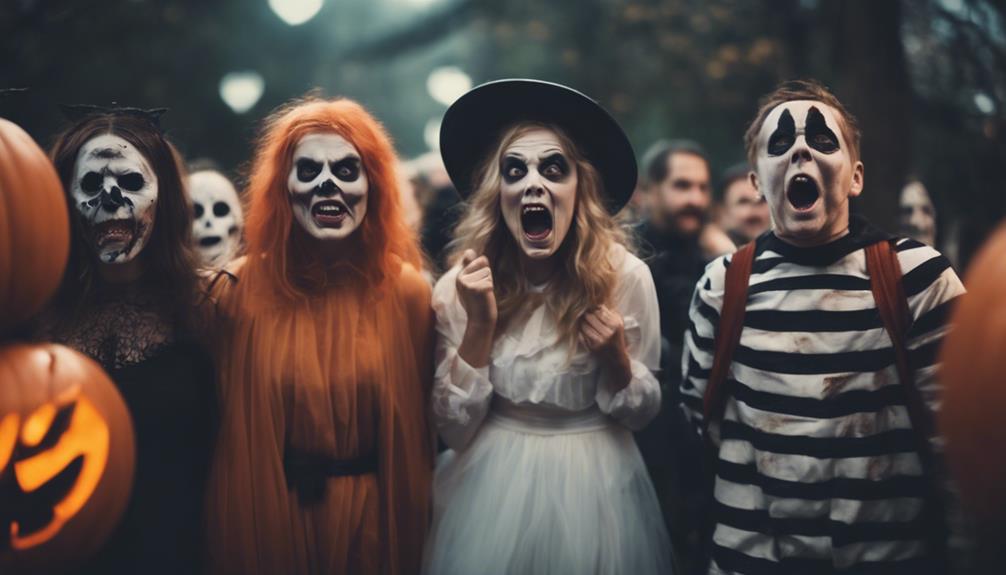
When it comes to social perceptions of scary Halloween costumes, it's important to take into account how these attires can be viewed differently based on cultural backgrounds and personal interpretations.
Some individuals see scary outfits as a way to confront their fears head-on and fully embrace the spooky essence of the holiday. Additionally, these costumes can serve as a form of entertainment, allowing people to engage in the thrill and excitement that Halloween brings.
Scary Costumes and Stigma
Scary costumes on Halloween often carry a stigma due to their association with fear and the supernatural. Social perceptions of scary attire can be influenced by cultural beliefs, societal norms, and media portrayals. Some individuals may make negative judgments about those wearing scary costumes, viewing them as attention-seeking or provocative. This stigma surrounding scary attire can also stem from historical associations with darkness and individual interpretations of what is considered appropriate. Despite these perceptions, many people enjoy donning scary costumes on Halloween as a form of creative expression and to partake in the excitement and celebration of the holiday.
| Scary Costumes Stigma | |
|---|---|
| Cultural Beliefs | Personal Experiences |
| Societal Norms | Media Portrayals |
| Negative Judgments | Historical Associations |
| Creative Expression | Excitement |
| Celebration |
Fear as Entertainment
Fear's grip on the human psyche is undeniable, often leading individuals to seek out thrill and entertainment through the donning of chilling costumes on Halloween. The allure of fear as entertainment lies in the controlled environment it provides, allowing people to experience a safe dose of adrenaline and excitement.
Scary attire offers a way to confront fears in a culturally accepted manner, making it a popular choice for Halloween celebrations. The enjoyment derived from wearing frightening costumes stems from the psychological desire for controlled fear, where individuals can experience the thrill of being scared without real danger.
This cultural acceptance of fear as a form of entertainment contributes to the widespread popularity of scary costumes during Halloween. By embracing the spooky and macabre, people can tap into their inner thrill-seeker in a fun and socially acceptable way.
Cultural Traditions in Horror
The origins of Halloween costumes can be traced back to ancient Celtic beliefs in spirits and the thin veil separating the living from the dead, influencing how society perceives and embraces scary attire. Cultural traditions in horror play a significant role in shaping social perceptions of scary costumes, with Halloween providing a platform to confront fears and celebrate the supernatural. Through the lens of these traditions, scary attire becomes not just a form of entertainment but a way to connect with the spiritual world and mock the idea of death itself.
The interplay of historical, religious, and commercial influences has contributed to the evolution of Halloween costumes, blending elements of tradition with contemporary trends. This fusion highlights the enduring appeal of scary attire in confronting darkness and fear within a cultural context. From classic ghostly figures to modern interpretations influenced by media and pop culture, the spectrum of scary costumes reflects societal interests and ongoing fascination with horror themes. Embracing these cultural traditions allows individuals to engage with their fears in a controlled and enjoyable manner, enriching the Halloween experience with a touch of spooky delight.
Marketing Influence on Costume Trends
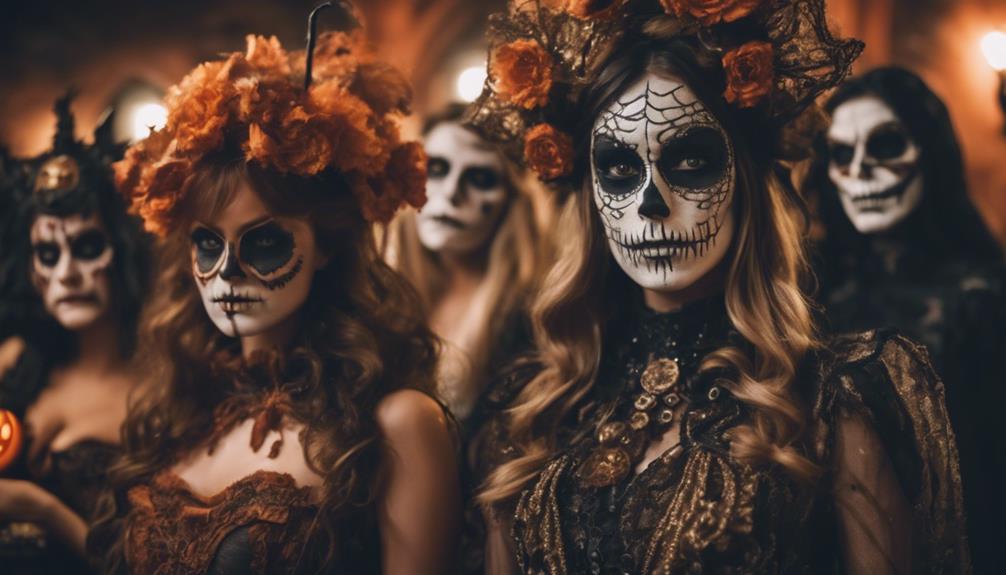
Marketing exerts a significant influence on the trends seen in Halloween costumes today. Costume manufacturers and retailers strategically leverage marketing tactics to shape consumer choices and preferences. Here are four key ways marketing impacts Halloween costume trends:
- Licensing Popular Characters: Marketers secure licenses for popular characters from movies, TV shows, and games, leading to a surge in costumes inspired by these beloved figures.
- Influence of Pop Culture Trends: Commercialization has resulted in a plethora of costumes reflecting current pop culture phenomena, ensuring that consumers can dress as their favorite trending characters.
- Consumer Engagement through Social Media: Social media platforms serve as powerful tools for promoting and influencing costume trends, allowing consumers to engage with and adopt popular styles.
- Diversity in Costume Options: The marketing strategies employed by costume manufacturers and retailers directly impact the variety and availability of costume options, catering to a wide range of consumer interests and preferences.
Future of Scary Costumes in Celebrations
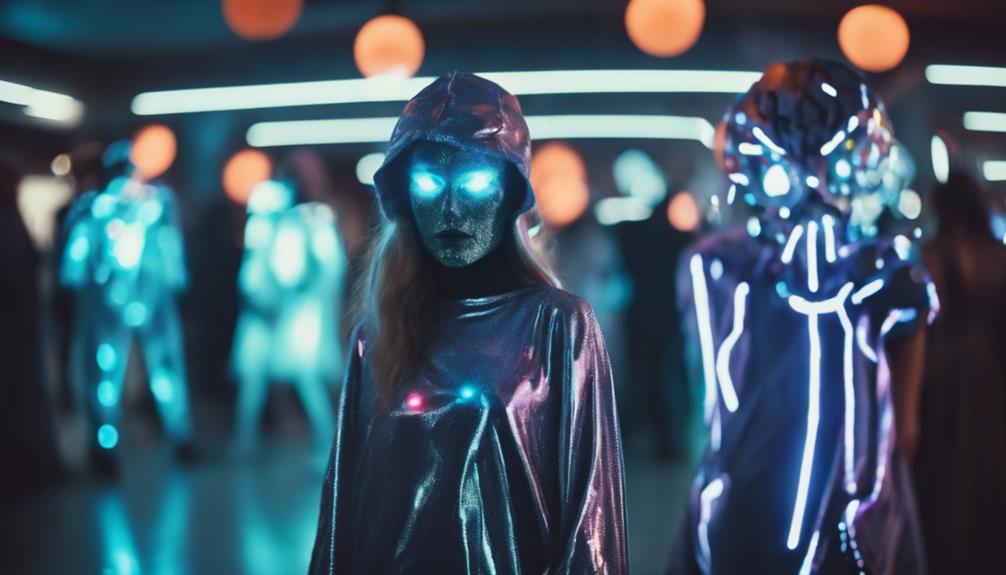
As celebrations evolve, anticipate a fusion of modern pop culture icons and classic horror elements in the domain of scary costumes. Predictions for the future of scary costumes in celebrations suggest a shift towards incorporating popular culture references alongside traditional spooky themes. This blend caters to individual preferences while also capitalizing on the psychological effects that these costumes can evoke, such as fear and excitement. Modern celebrations are likely to see an increased influence of societal norms and commercial interests shaping the acceptance and prevalence of scary costumes.
| Predictions | Popular Culture | Psychological Effects |
|---|---|---|
| Incorporation of | Integration of modern | Triggers fear, anxiety, |
| modern pop culture | pop culture icons and | and physiological |
| references in | characters from horror | responses during |
| scary costumes | movies | Halloween festivities |
This evolution reflects a dynamic interplay between historical traditions and contemporary influences, paving the way for a diverse range of frightening and enthralling costume choices in future celebrations.
Frequently Asked Questions
Why Do People Wear Scary Costumes During Halloween?
When it comes to Halloween, people wear scary costumes to embrace the holiday's spooky vibes and have fun.
It's a way to confront fears, express interest in the supernatural, and enjoy the thrill of the season.
By donning these spooky outfits, individuals tap into the ancient tradition of warding off evil spirits while adding excitement to Halloween celebrations.
Are You Supposed to Wear Scary Costumes on Halloween?
You don't have to wear scary costumes on Halloween. It's all about personal preference and how you want to celebrate the holiday.
Whether you choose to go spooky or not, the most important thing is to have fun and enjoy the festivities. So, feel free to dress up as something frightening or opt for a different costume that suits your style.
Just make sure you're comfortable and ready to have a great time!
Why Do We Do Scary Things on Halloween?
You do scary things on Halloween to embrace the holiday's history rooted in ancient beliefs about spirits crossing over.
Scary activities like haunted houses and costumes add an element of thrill and excitement to the celebration. Engaging in spooky traditions allows you to confront fears and immerse yourself in the supernatural aspects of Halloween.
It's a way to have fun, experience a rush of adrenaline, and indulge in the eerie atmosphere of the season.
Why Is Halloween Associated With Horror?
Halloween is associated with horror due to its historical ties to ancient Celtic festivals like Samhain. The blurred line between the living and the dead during this time created a need for disguises and scary attire to blend in with spirits.
The tradition of donning frightening costumes on October 31st has persisted, reinforced by modern depictions of monsters and ghosts in popular culture. The appeal of scary costumes lies in the thrill of fear and the excitement of confronting the unknown.
Conclusion
To wrap up, the tradition of wearing scary costumes on Halloween dates back to ancient beliefs and has evolved over time to become a cultural phenomenon.
The psychological impact of these outfits adds an element of thrill to the holiday, while social perceptions and marketing trends continue to shape costume choices.
As the future of scary costumes remains uncertain, remember the age-old adage: 'It's better to be safe than sorry' when choosing your Halloween attire.
Choose wisely and have a spooktacular time!
